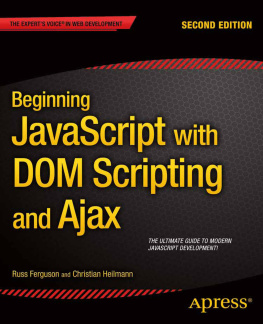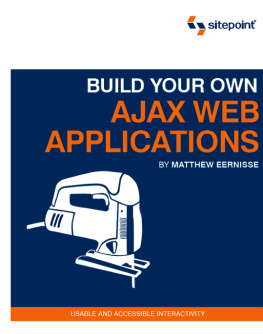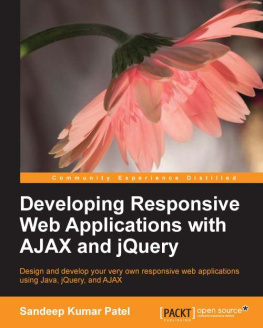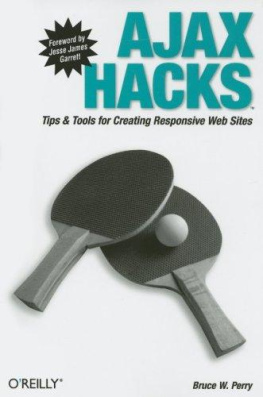Appendix . About the Author
Dino Esposito
Dino Esposito is an IDesign ( http://www.idesign.net ) architect and a trainer based in Rome, Italy. Dino specializes in Microsoft Web technologies, including ASP.NET AJAX and Silverlight, and spends most of his time teaching and consulting across Europe, Australia, and the United States.
Over the years, Dino has developed hands-on experience and skills in architecting and building distributed systems for banking and insurance companies and, in general, in industry contexts where the demand for security, optimization, performance, scalability, and interoperability is dramatically high. Every month, a variety of magazines and Web sites throughout the world publish Dinos articles on topics ranging from Web development to data access and from software best practices to Web services. A prolific author, Dino writes the monthly "Cutting Edge" column for MSDN Magazine and the "ASP.NET-2-The-Max" newsletter for Dr. Dobbs Journal . As a widely acknowledged expert in Web applications built with .NET technologies, Dino contributes to the Microsoft content platform for developers and IT consultants. Check out his articles on a variety of MSDN Developer Center topics, such as ASP.NET, security, and data access.
Dino has written an array of books, most of which are considered state of the art in their respective areas. His more recent books are Microsoft .NET: Architecting Applications for the Enterprise (co-authored by Andrea Saltarello) and Programming Microsoft ASP.NET 3.5 , both from Microsoft Press (2008). Dino regularly speaks at industry conferences all over the world (including Microsoft TechEd, Microsoft DevDays, DevConnections, DevWeek, and Basta) and local technical conferences and meetings in Europe and the United States.
Dino lives near Rome and keeps in shape playing tennis at least twice a week at CT Monterotondo.
Chapter 1. Under the Umbrella of AJAX
Forget what we think we know about the limitations of the Web, and begin to imagine a wider, richer range of possibilities.
JesseJamesGarrett
In 2007, more or less at the same time I was proudly showcasing my hot new book on ASP.NET AJAX, an old friend of mine started investigating the features of AJAX and the still largely unknown Silverlight platform. He had just been given the task of planning and coordinating a huge migration project within his company.
He spent about ten years building, maintaining, and progressively enhancing a vertical application that had won an industry award and was aimed at some special categories of professionals, such as lawyers and public accountants. At some point, his company had been acquired by a larger group and the old application had to be integrated into an existing Web platform.
With the whole company about to abruptly switch from a desktop mindset to a Web paradigm, my friend was trying to be reasonably thoughtful. He was looking for the best available tools of the current Web paradigm to minimize the pain and costs of migration while delivering an effective, desktop-like experience to the existing users. With all the buzz and hype around AJAX (and that fancy new thing known as Silverlight), his efforts seemed to be a matter of prudence and the fruit of an innate "try before you buy" attitude.
I met my friend at TechEd 2007, where I was giving a couple of presentations on the subject of ASP.NET AJAX. To my greatest surprise, at the end of my last session he came by and whispered apologetically, "Sorry Dino, but is that all of it?" He was aware that his question might sound insolent or silly and that it undermined the beautiful story I had just told the audience.
My presentation had been about how a new age of prosperity and success was about to begin for all Web developers and architects. It included the success story of how one of the building blocks of Web 2.0 came along. I told the fantastic story of how the Web was, all of a sudden, about to offer the same set of functionality as the desktop.
Unfortunately, the Web is not the desktop.
And it will never be like that, no matter which moderating suffix you attach to the word desktop . You can label the Web as desktop over HTTP or browser-hosted desktop or even desktop in the cloud . It is, and will always be, a pure marketing gimmick.
What Web Do We Want?
My friend got it right quite quickly. The Web is the Web, with its pros and cons. Using AJAX (or even Silverlight) as a shortcut or, worse yet, as a magic wand to simplify developmentfrom developing new commercial Web sites to performing complex enterprise migration projectsis just incorrect. And its potentially a deadly decision with regard to the assets of a company.
My friend, who looked at AJAX with a totally unbiased mind, had the farsightedness to clearly and quickly see that AJAX was something important for Web-related development but that it was not the easy fix that many people were enthusiastically depicting it to be. (And to some extent, its still being depicted that way today, two years later.)
In light of this, the following equation is not realistic:
desktop = Web + AJAX
It doesnt work outside the dreams of some IT managers.
Although my friend had perceived the key facts about AJAX, his insight didnt solve his primary concern. By figuring out AJAX quickly, though, he was able to focus his brainstorming in the right direction and center his thoughts around the right questions.
So what are the right questions to ask about AJAX?
Its All About User Experience
As I see things, theres just one key question, and a number of more technical and in-depth questions spread out from this question later. The fundamental question is, "What Web do we want?"
Admittedly, the question implies we are not entirely happy with todays Web and are looking for a different type of Web. At the end of the day, what we all want from the Web is a much better user experience , in the broadest possible meaning of both the term user and the term experience .
So what does user experience mean to various people?
User Experience for Dummies
Jesse James Garrett has made it into the history books as the man who coined the now ubiquitous and universal acronym AJAX , back in 2005. (To read the full story, pay a visit to http://www.adaptivepath.com/ideas/essays/archives/000385.php .)
For readers who might have spent the last three years in a remote rainforest with no connectivity at all, Ill spell out the acronym hereAsynchronous JavaScript And XML. (Later in the chapter, Ill comment on the role and importance of each part of the acronym.)
Jesse James Garrett, however, is neither a software architect nor a Web developer. He calls himself an experience designer, and hes also the author of a widely referenced book on Web design titled The Elements of User Experience (New Riders Press, 2002). In short, Jesse James Garrett is probably one of the most qualified people in the world to give us a concise and comprehensible definition of user experience (UE).
Understanding the whys and wherefores of UE is the first step to understanding what Web we want and how to go forward and look for valid technologies to employ in its implementation.
The concept of UE is made of many disparate parts. Creating a positive user experience for a Web site involves enabling end users to use the site for their own purposes, which might include business, work, personal activities and interests, and entertainment. UE is about how a Web site (or, generally, any system) is perceived, learned about, and finally used; and how a user feels about that.

![Dino Esposito [Dino Esposito] Microsoft® ASP.NET and AJAX: Architecting Web Applications](/uploads/posts/book/120575/thumbs/dino-esposito-dino-esposito-microsoft-asp-net.jpg)







